Documenting terror: Lynching memorial opens
- Jim Glynn
- Apr 27, 2018
- 4 min read
In the American criminal justice system, wealth — not culpability — shapes outcomes. Indigent people are unfairly disadvantaged at every step in a system that treats the rich and guilty better than the poor and innocent. Equal Justice Initiative
This past Thursday, April 26, the general public was welcomed to the opening of the National Memorial for Peace and Justice, the first memorial that is dedicated to the legacy of enslaved black people, people terrorized by lynching, and people humiliated by racial segregation and Jim Crow (laws that promoted racial discrimination, particularly in the southern states after the Civil War).
In 2010, after the staff of the Equal Justice Initiative (EJI) had investigated thousands of lynchings in the South — many of which had never been documented — work began on an ambitious project to bring the history of racial violence to modern consciousness. According to the EJI website, the organization “was interested not only in lynching incidents, but in understanding the terror and trauma this sanctioned violence against the black community created.”
Perhaps that terror can be understood by the African American diaspora, the mass evacuation of the South by racial minorities.
The EJI claims that “six million black people fled the South as refugees and exiles as a result of these ‘racial terror lynchings.’” The main buildings and their surrounding systems were created by the non-profit organization in Montgomery, Alabama, which was founded by Bryan Stevenson in 1994. Stevenson, a Professor of Law at the New York University School of Law, serves as the executive director. He recently won a series of cases before the U.S. Supreme Court that resulted in a ruling that mandatory life-without-parole sentences for all children 17 or younger are unconstitutional.
The memorial was built because, according to Stevenson, “In the American South, we don’t talk about slavery. We don’t have monuments and memorials that confront the difficulties of segregation. And… we are still burdened by that history.”
To rectify the historical omission, “Lynching in America: Confronting the Legacy of Racial Terror” was produced in 2015. It documents thousands of cases in twelve Southern states and 800 counties throughout the nation. Venues
The entire memorial covers six acres of land overlooking Montgomery. There are two venues at the site: The National Memorial for Peace and Justice and The Legacy Museum: From Enslavement to Mass Incarceration.
The Memorial reminds viewers of the racial minorities (mostly African American) who were illegally hanged, while the Museum traces history from the days of slavery to the mass imprisonment of black Americans today.
The purpose of the project is to portray a kind of time-lapse photograph of the country, particularly the South, that is both “more complete and less triumphant” than is usually depicted in books and films, according to Nia-Malika Henderson, senior reporter for CNN.
For example, Stevenson and a research team spent years combing through court records and newspapers and talking with local historians, documenting more than 4,000 lynchings that have taken place in the United States. Historical amnesia
Stevenson told the Los Angeles Times, “Most people in this country can’t name a single African American who was lynched between 1877 and 1950 even though thousands of African Americans were subjected to this violence.” He claims that extra-legal lynchings were conducted in order to impose fear on racial minorities and maintain strict control by the white community. Therefore, he refers to these incidents as “racial terror lynchings.”
E.M Beck, professor emeritus of sociology at the University of Georgia opined in the L.A. Times article, “I think (the number of lynchings) is an underestimate because the number and amount of violence in early Reconstruction in the 1870s will probably never be known. There was just an incredible amount of violence taking place during that period of time.”
The National Memorial for Peace and Justice was devised in order to create “a sober, meaningful site where people can gather and reflect on America’s history of racial inequality.” According to EJI, the organization partnered with artists like Kwame Akoto-Bamfo, a sculptor, to present a visual reminder of a shameful time in the nation’s development.
Another sculptor, Dana King, has created works that memorialize the women who participated in and sustained the Montgomery Bus Boycott, which began when Rosa Parks refused to give up her bus seat to a white person in 1955. Work by Hank Willis Thomas depicts incidents of racially biased criminal justice in modern society. And the visual arts are supplemented by the writings of people like Dr. Martin Luther King, Jr., Ida B. Wells, and Toni Morrison. Grim reminders
At the center of the site is a structure that contains more than 800 rectangular steel blocks, each six feet tall. There is one block for each county where a documented lynching took place. And, each of these columns is engraved with the names of the lynching victims in the county.
As people step into the structure, the floor begins to lower, making the columns, which are suspended from beams that form the top of the monument, appear to rise. The experience presents a visual and brutal representation of the lynchings that are part of our history.
A field of identical monuments surround the memorial center. It is hoped that each county that has experienced a lynching in its past will claim one of monuments and place it in a conspicuous location. According to the EJI, “Over time, the national memorial will serve as a report on which parts of the country have confronted the truth of this terror and which have not.”
The purpose of this exercise is clear: We must confront our history in order to overcome it. According to the EJI, “A history of racial injustice must be acknowledged, and mass atrocities and abuse must be recognized and remembered, before a society can recover from mass violence.” The National Memorial for Peace and Justice provides a venue for reflection, a place to conceptualize the net effect of practices that produced an era of racial violence.
• • •
Jim Glynn may be contacted at j_glynn@att.net.


























Comments